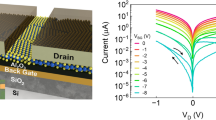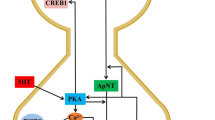Abstract
The membrane potential difference between two adjacent neurons can induce an electromagnetic induction current that behaves like a memristor synapse effect using to couple these two neurons. Based on two-dimensional (2D) Hindmarsh–Rose (HR) neuron and non-ideal threshold memristor, this paper presents a five-dimensional (5D) neuron model of two adjacent neurons coupled by memristive electromagnetic induction. With the 5D memristor-coupled neuron model, the equilibrium states and their stabilities are investigated by qualitative analyses, and the coexisting phenomena of multiple firing patterns and initials-depending bifurcation routes along with extreme events are then uncovered by numerical simulations. Due to complex stabilities of the seven equilibrium states, the attraction basin of one neuron in the 5D memristor-coupled neuron model is not only related to the coupling strength of memristor synapse but also associated with another neuron initials, leading to that the coexisting multiple firing patterns are emerged from different regions in the attraction basin and the bifurcation routes are closely dependent to the initials. Furthermore, circuit syntheses using the off-the-shelf components and breadboard experiments for the proposed 5D memristor-coupled neuron model are executed so that the coexisting multiple firing patterns and extreme events are then conformed perfectly, which have not yet been previously reported in the coupled HR neuron model.












Similar content being viewed by others
References
Hodgkin, A.L., Huxley, A.F.: A quantitative description of membrane current and its application to conduction and excitation in nerve. J. Physiol. 117, 500–544 (1952)
Xu, Y., Jia, Y., Ge, M.Y., Lu, L.L., Yang, L.J., Zhan, X.: Effects of ion channel blocks on electrical activity of stochastic Hodgkin–Huxley neural network under electromagnetic induction. Neurocomputing 283, 196–204 (2018)
Morris, C., Lecar, H.: Voltage oscillations in the barnacle giant muscle fiber. Biophys. J. 35(1), 193–213 (1981)
Tsumoto, K., Kitajima, H., Yoshinaga, T., Aihara, K., Kawakami, H.: Bifurcations in Morris–Lecar neuron model. Neurocomputing 69(4–6), 293–316 (2006)
Wu, X.Y., Ma, J., Yuan, L.H., Liu, Y.: Simulating electric activities of neurons by using PSPICE. Nonlinear Dyn. 75(1–2), 113–126 (2014)
Izhikevich, E.M.: Simple model of spiking neurons. IEEE Trans. Neural Netw. 14(6), 1569–1572 (2003)
Mineeja, K.K., Ignatius, R.P.: Spatiotemporal activities of a pulse-coupled biological neural network. Nonlinear Dyn. 92(4), 1881–1897 (2018)
Hindmarsh, J.L., Rose, R.M.: A model of the nerve impulse using two first-order differential equations. Nature 296(5853), 162–164 (1982)
Hindmarsh, J.L., Rose, R.M.: A model of neuronal bursting using three coupled first order differential equations. Proc. R. Soc. Lond. B Biol. Sci. 221(1222), 87–102 (1984)
Innocenti, G., Genesio, R.: On the dynamics of chaotic spiking-bursting transition in the Hindmarsh–Rose neuron. Chaos 19(2), 023124 (2009)
Innocenti, G., Morelli, A., Genesio, R., Torcini, A.: Dynamical phases of the Hindmarsh–Rose neuronal model: studies of the transition from bursting to spiking chaos. Chaos 17(4), 043128 (2007)
Gu, H.: Biological experimental observations of an unnoticed chaos as simulated by the Hindmarsh–Rose model. PLoS ONE 8(12), e81759 (2013)
Gu, H.G., Pan, B.B., Chen, G.R., Duan, L.X.: Biological experimental demonstration of bifurcations from bursting to spiking predicted by theoretical models. Nonlinear Dyn. 78(1), 391–407 (2014)
Chay, T.R.: Chaos in a three-variable model of an excitable cell. Physica D 16, 233–242 (1985)
Chay, T.R., Fan, Y.S., Lee, S.: Bursting, spiking, chaos, fractals and universality in biological rhythms. Int. J. Bifurcat. Chaos 5, 595–635 (1995)
Ngouonkadi, E.B.M., Fotsin, H.B., Fotso, P.L., Tamba, V.K., Cerdeira, H.A.: Bifurcations and multistability in the extended Hindmarsh–Rose neuronal oscillator. Chaos Solitons Fractals 85, 151–163 (2016)
Wu, K.J., Luo, T.Q., Lu, H.W., Wang, Y.: Bifurcation study of neuron firing activity of the modified Hindmarsh–Rose model. Neural Comput. Appl. 27(3), 739–747 (2016)
Kaslik, E.: Analysis of two- and three-dimensional fractional-order Hindmarsh–Rose type neuronal models. Fract. Calc. Appl. Anal. 20(3), 623–645 (2017)
Dong, J., Zhang, G.J., Xie, Y., Yao, H., Wang, J.: Dynamic behavior analysis of fractional-order Hindmarsh–Rose neuronal model. Cogn. Neurodyn. 8(2), 167–175 (2014)
Wang, H., Zheng, Y., Lu, Q.: Stability and bifurcation analysis in the coupled HR neurons with delayed synaptic connection. Nonlinear Dyn. 88(3), 2091–2100 (2017)
Lakshmanan, S., Lim, C.P., Nahavandi, S., Prakash, M., Balasubramaniam, P.: Dynamical analysis of the Hindmarsh–Rose neuron with time delays. IEEE Trans. Neural Netw. Learn. 28(8), 1953–1958 (2017)
Thottil, S.K., Ignatius, R.P.: Nonlinear feedback coupling in Hindmarsh–Rose neurons. Nonlinear Dyn. 87(3), 1879–1899 (2017)
Ma, J., Tang, J.: A review for dynamics of collective behaviors of network of neurons. Sci. China Technol. Sci 58(12), 2038–2045 (2015)
Wu, J., Xu, Y., Ma, J.: Lévy noise improves the electrical activity in a neuron under electromagnetic radiation. PLoS ONE 12, e0174330 (2017)
Lv, M., Wang, C., Ren, G., Ma, J., Song, X.: Model of electrical activity in a neuron under magnetic flow effect. Nonlinear Dyn. 85(3), 1479–1490 (2016)
Wang, Y., Ma, J., Xu, Y., Wu, F., Zhou, P.: The electrical activity of neurons subject to electromagnetic induction and Gaussian white noise. Int. J. Bifurc. Chaos 27(2), 1750030 (2017)
Wu, F.Q., Wang, C.N., Jin, W.Y., Ma, J.: Dynamical responses in a new neuron model subjected to electromagnetic induction and phase noise. Physica A 469, 81–88 (2017)
Xu, Y., Jia, Y., Ma, J., Alsaedi, A., Ahmad, B.: Synchronization between neurons coupled by memristor. Chaos Soliton Fractals 104, 435–442 (2017)
Ma, J., Lv, M., Zhou, P., Xu, Y., Hayat, T.: Phase synchronization between two neurons induced by coupling of electromagnetic field. Appl. Math. Comput. 307, 321–328 (2017)
Ren, G.D., Xu, Y., Wang, C.N.: Synchronization behavior of coupled neuron circuits composed of memristors. Nonlinear Dyn. 88(2), 893–901 (2017)
Corinto, F., Ascoli, A., Lanza, V., Gilli, M.: Memristor synaptic dynamics’ influence on synchronous behavior of two Hindmarsh–Rose neurons. In: The 2011 International Joint Conference on Neural Networks (IJCNN), pp. 2403–2408. IEEE (2011)
Xu, F., Zhang, J., Fang, T., Huang, S., Wang, M.: Synchronous dynamics in neural system coupled with memristive synapse. Nonlinear Dyn. 92(3), 1395–1402 (2018)
Bao, B.C., Hu, A.H., Bao, H., Xu, Q., Chen, M., Wu, H.G.: Three-dimensional memristive Hindmarsh–Rose neuron model with hidden coexisting asymmetric behaviors. Complexity 2018, 3872573 (2018)
Ge, M.Y., Jia, Y., Xu, Y., Yang, L.J.: Mode transition in electrical activities of neuron driven by high and low frequency stimulus in the presence of electromagnetic induction and radiation. Nonlinear Dyn. 91(1), 515–523 (2018)
Lu, L.L., Jia, Y., Liu, W.H., Yang, L.J.: Mixed stimulus-induced mode selection in neural activity driven by high and low frequency current under electromagnetic radiation. Complexity 2017, 7628537 (2017)
Lv, M., Ma, J.: Multiple modes of electrical activities in a new neuron model under electromagnetic radiation. Neurocomputing 205, 375–381 (2016)
Faisal, A.A., Selen, L.P.J., Wolpert, D.M.: Noise in the nervous system. Nat. Rev. Neurosci. 9(4), 292–303 (2008)
Bao, B.C., Hu, A.H., Xu, Q., Bao, H., Wu, H.G., Chen, M.: AC induced coexisting asymmetric bursters in the improved Hindmarsh–Rose model. Nonlinear Dyn. 92(1), 1695–1706 (2018)
Pinto, R.D., Varona, P., Volkovskii, A.R., Szücs, A., Abarbanel, H.D., Rabinovich, M.I.: Synchronous behavior of two coupled electronic neurons. Phys. Rev. E 62(2), 2644–2656 (2000)
De, L.E., Hasler, M.: Oscillations and oscillatory behavior in small neural circuits. Biol. Cybern. 95(6), 537–554 (2006)
Linaro, D., Poggi, T., Storace, M.: Experimental bifurcation diagram of a circuit-implemented neuron model. Phys. Lett. A 374, 4589–4593 (2011)
Dahasert, N., Öztürk, I., Kiliç, R.: Experimental realizations of the HR neuron model with programmable hardware and synchronization applications. Nonlinear Dyn. 70(4), 2343–2358 (2012)
Bao, B.C., Qian, H., Xu, Q., Chen, M., Wang, J., Yu, Y.J.: Coexisting behaviors of asymmetric attractors in hyperbolic-type memristor based Hopfield neural network. Front. Comput. Neurosci. 11(81), 1–14 (2017)
Saha, A., Feudel, U.: Riddled basins of attraction in systems exhibiting extreme events. Chaos 28(3), 033610 (2018)
Chaudhuri, U., Prasad, A.: Complicated basins and the phenomenon of amplitude death in coupled hidden attractors. Phys. Lett. A 378(9), 713–718 (2014)
Hu, X.Y., Liu, C.X., Liu, L., Ni, J.K., Li, S.L.: An electronic implementation for Morris–Lecar neuron model. Nonlinear Dyn. 84(4), 2317–2332 (2016)
Bao, B.C., Jiang, T., Wang, G.Y., Jin, P.P., Bao, H., Chen, M.: Two-memristor-based Chua’s hyperchaotic circuit with plane equilibrium and its extreme multistability. Nonlinear Dyn. 89(2), 1157–1171 (2017)
Korn, H., Faure, P.: Is there chaos in the brain II. Experimental evidence and related models. C. R. Biol. 326(9), 787–840 (2003)
Acknowledgements
This work was supported by the grants from the National Natural Science Foundations of China under 51777016, 61471191, and 61601062, and the Aeronautical Science Foundation of China under 20152052026.
Author information
Authors and Affiliations
Corresponding author
Ethics declarations
Conflict of interest
The authors declare that they have no conflicts of interest. These authors contribute equally to this work.
Rights and permissions
About this article
Cite this article
Bao, H., Liu, W. & Hu, A. Coexisting multiple firing patterns in two adjacent neurons coupled by memristive electromagnetic induction. Nonlinear Dyn 95, 43–56 (2019). https://doi.org/10.1007/s11071-018-4549-7
Received:
Accepted:
Published:
Issue Date:
DOI: https://doi.org/10.1007/s11071-018-4549-7




